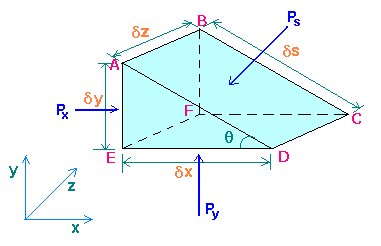Question #27796
1 Answer
Pascal's law states that pressure exerted anywhere in a confined incompressible fluid is transmitted equally in all directions throughout the fluid.
Explanation:
Proof
Consider an infinitesimal element of fluid in the form of a triangular prism containing a point

Let the pressures
There can be no shearing forces for a fluid in equilibrium. As such the sum of the forces in any direction must be zero. The forces acting are due to the pressures on the surrounding and the gravity.
Knowing the definition of pressure and that
Sum of forces in the
Since
From (1) and (2) we get
By selecting orientation of coordinate system appropriately the above expression could be extended to include the
In the limiting case the element can be considered a point so the derived expression indicates that pressure at any point is the same in all directions.
